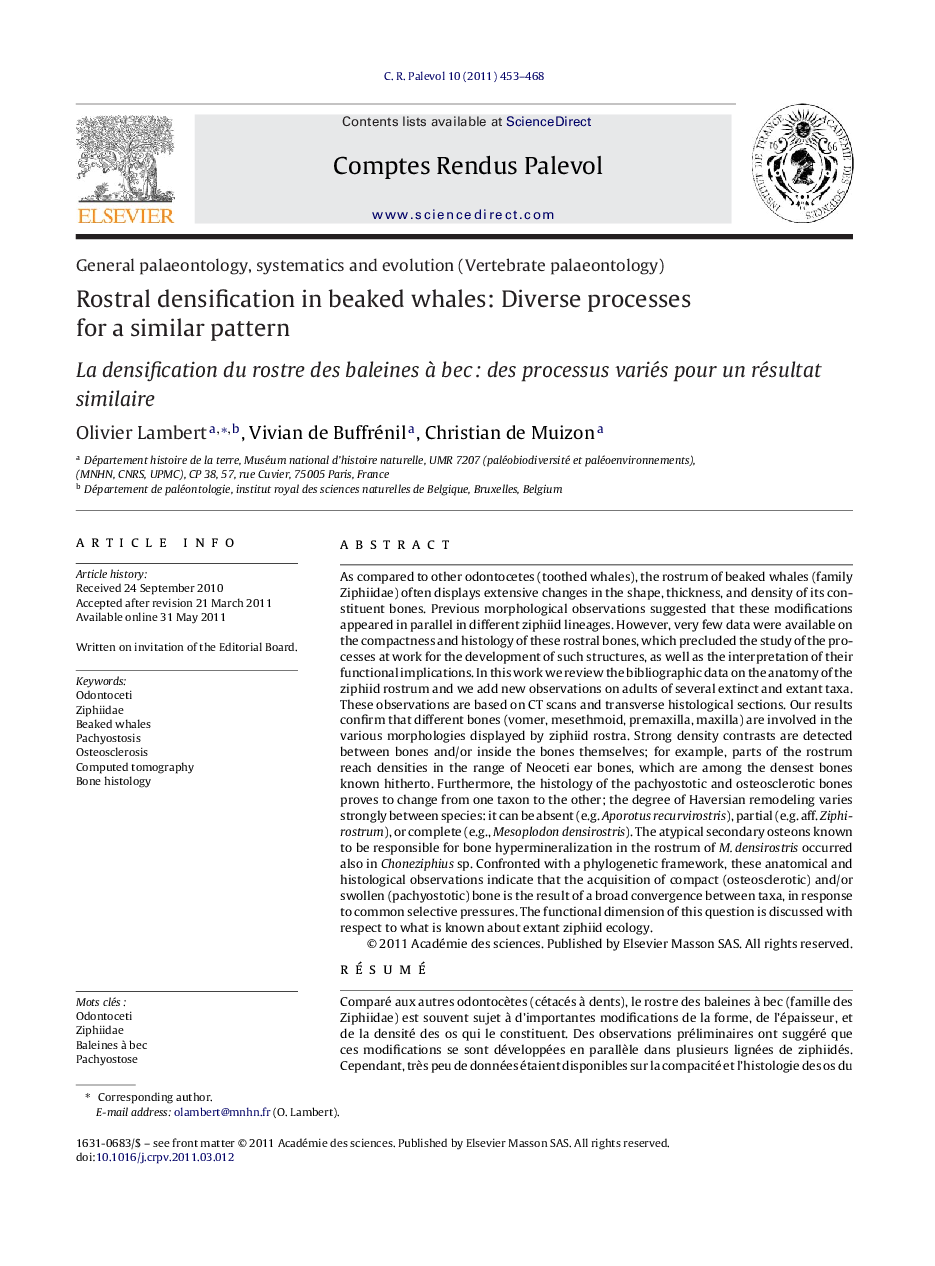| کد مقاله | کد نشریه | سال انتشار | مقاله انگلیسی | نسخه تمام متن |
|---|---|---|---|---|
| 4746396 | 1642009 | 2011 | 16 صفحه PDF | دانلود رایگان |

As compared to other odontocetes (toothed whales), the rostrum of beaked whales (family Ziphiidae) often displays extensive changes in the shape, thickness, and density of its constituent bones. Previous morphological observations suggested that these modifications appeared in parallel in different ziphiid lineages. However, very few data were available on the compactness and histology of these rostral bones, which precluded the study of the processes at work for the development of such structures, as well as the interpretation of their functional implications. In this work we review the bibliographic data on the anatomy of the ziphiid rostrum and we add new observations on adults of several extinct and extant taxa. These observations are based on CT scans and transverse histological sections. Our results confirm that different bones (vomer, mesethmoid, premaxilla, maxilla) are involved in the various morphologies displayed by ziphiid rostra. Strong density contrasts are detected between bones and/or inside the bones themselves; for example, parts of the rostrum reach densities in the range of Neoceti ear bones, which are among the densest bones known hitherto. Furthermore, the histology of the pachyostotic and osteosclerotic bones proves to change from one taxon to the other; the degree of Haversian remodeling varies strongly between species: it can be absent (e.g. Aporotus recurvirostris), partial (e.g. aff. Ziphirostrum), or complete (e.g., Mesoplodon densirostris). The atypical secondary osteons known to be responsible for bone hypermineralization in the rostrum of M. densirostris occurred also in Choneziphius sp. Confronted with a phylogenetic framework, these anatomical and histological observations indicate that the acquisition of compact (osteosclerotic) and/or swollen (pachyostotic) bone is the result of a broad convergence between taxa, in response to common selective pressures. The functional dimension of this question is discussed with respect to what is known about extant ziphiid ecology.
RésuméComparé aux autres odontocètes (cétacés à dents), le rostre des baleines à bec (famille des Ziphiidae) est souvent sujet à d’importantes modifications de la forme, de l’épaisseur, et de la densité des os qui le constituent. Des observations préliminaires ont suggéré que ces modifications se sont développées en parallèle dans plusieurs lignées de ziphiidés. Cependant, très peu de données étaient disponibles sur la compacité et l’histologie des os du rostre, ce qui a empêché l’étude des processus à l’œuvre dans le développement de telles structures, ainsi que l’interprétation des implications fonctionnelles de celles-ci. Dans ce travail, nous passons en revue les données bibliographiques sur l’anatomie du rostre des ziphiidés et ajoutons des observations nouvelles sur les adultes de plusieurs taxons éteints et actuels. Ces observations ont été collectées à l’aide de deux moyens : la tomographie informatisée et la confection de lames minces transversales. Nos résultats confirment que des os différents (vomer, mésethmoïde, prémaxillaire, maxillaire) sont impliqués dans les changements morphologiques variés, observés dans différents taxons de ziphiidés. De forts contrastes de densité sont également détectés entre les os et/ou au sein des os eux-mêmes ; certaines parties du rostre atteignent, par exemple, des densités similaires à celle des os de l’oreille des Neoceti, qui figurent parmi les plus denses connus. De plus, l’histologie des os pachyostotiques et ostéosclérotiques s’est avérée changer d’un taxon à l’autre ; le degré du remaniement haversien varie fortement entre les espèces : il peut être nul (e.g., Aporotus recurvirostris), partiel (e.g., aff. Ziphirostrum), ou complet (e.g., Mesoplodon densirostris). Des ostéones secondaires atypiques, connus comme étant responsables d’une hyperminéralisation osseuse dans le rostre de M. densirostris, sont également détectés dans Choneziphius sp. Confrontées à un cadre phylogénétique, ces observations anatomiques et histologiques indiquent que l’acquisition d’os compacts (ostéosclérotiques) et/ou renflés (pachyostotiques) est le résultat d’une convergence entre taxons, en réponse à des pressions de sélection communes. L’aspect fonctionnel de cette question est discuté, en rapport avec ce qui est connu de l’écologie des ziphiidés actuels.
Journal: Comptes Rendus Palevol - Volume 10, Issues 5–6, July–September 2011, Pages 453–468